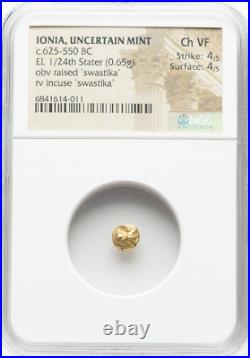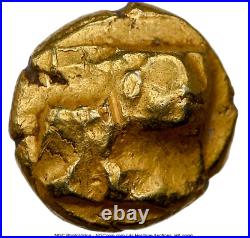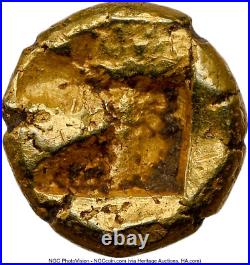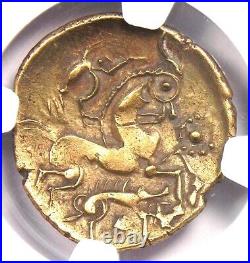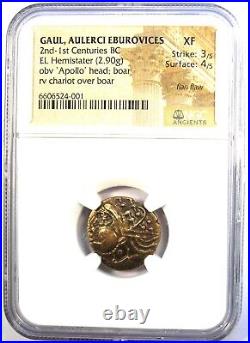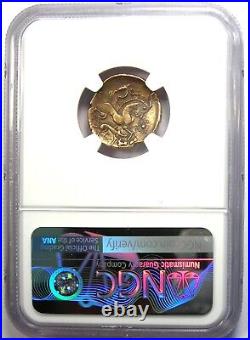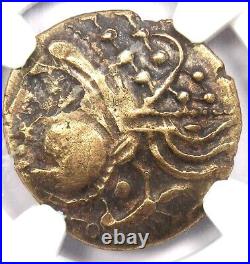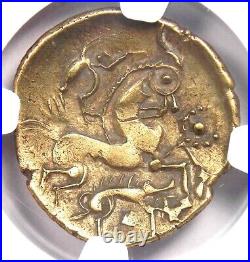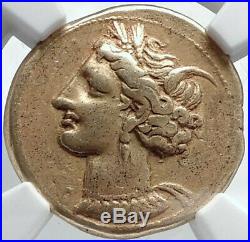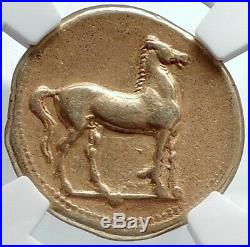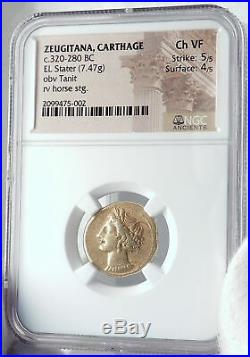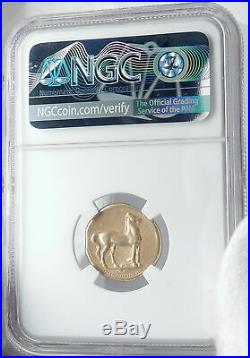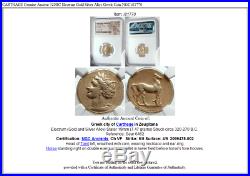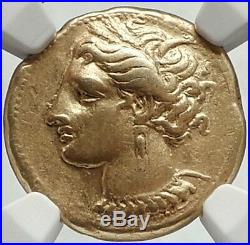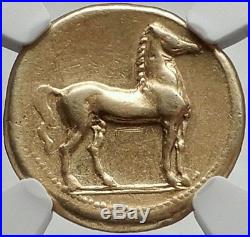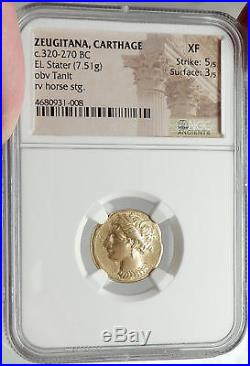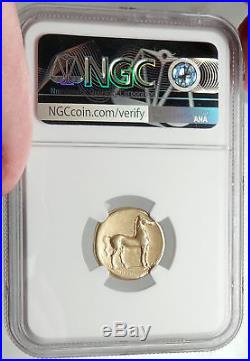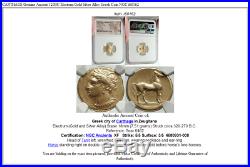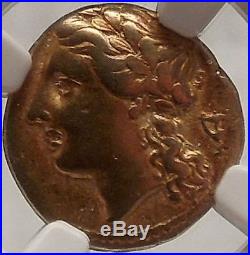
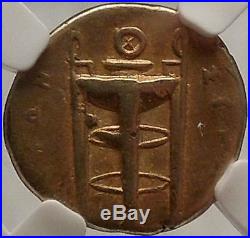

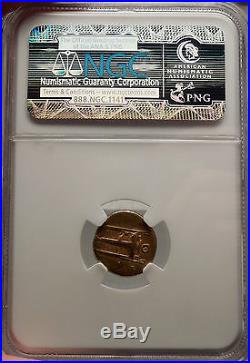

[5934] Greek city of Syracuse in Sicily under Tyrant Agathokles Electrum Dekadrachm or 50 Litrai 15mm (3.45 grams) Struck circa 310-300 B. Reference: HGC 2, 1294; BAR Issue 10. BMC 263 (same dies); Jenkins Group B; (O4/R1). SNG ANS 621 Certification: NGC Ancients VF Strike: 4/5 Surface: 4/5 3761048-008 Laureate head of Apollo to left; behind, amphora. Excellent early Hellenistic style. When in it’s foundations that the city of Syracuse only consisted of the island of Ortygia, that island was said to have been the home of the nymph Arethusa. She had been a chaste, faithful attendant of Artemis. It is said that she got the unwanted attentions from the river god, Alpheios, while bathing in his Peloponnesian stream. Artemis hid her in a cloud in an attempt to save her, however she sweated so profusely out of fear that she was transformed into a stream. Artemis broke apart the ground to allow her to escape. She found her way to the island of Ortygia where she became the fountain on that island. Agathocles (361-289 BC) was a Greek tyrant of Syracuse (317-289 BC) and king of Sicily (304-289 BC). Agathocles was born at Thermae Himeraeae (modern name Termini Imerese) in Sicily. The son of a potter who had moved to Syracuse in about 343 BC, he learned his father’s trade, but afterwards entered the army along with his brother Antander. In 333 BC he married the widow of his patron Damas, a distinguished and wealthy citizen. He was twice banished for attempting to overthrow the oligarchical party in Syracuse. Having banished or murdered some 10,000 citizens, and thus made himself master of Syracuse, he created a strong army and fleet and subdued the greater part of Sicily. War with Carthage followed. In 311 BC Agathocles was defeated in the Battle of the Himera River and besieged in Syracuse. In 310 BC he made a desperate effort to break through the blockade and attack the enemy in Africa. In 309/8 BC, Agathocles turned his attention towards Ophellas ruler of Cyrenaica as likely to prove a useful ally in his war against the Carthaginians. In order to gain him over he promised to cede to him whatever conquests their combined forces might make in Africa, reserving to himself only the possession of Sicily. Ophellas gathered a powerful army from the homeland of his wife Euthydike (a descendant of Miltiades) Athens, where many citizens felt disgruntled after having lost their voting rights. Notwithstanding all the natural obstacles which presented themselves on his route, succeeded in reaching the Carthaginian territories after a toilsome and perilous march of more than two months’ duration. He was received by Agathocles with every demonstration of friendship, and the two armies encamped near each other: but not many days had elapsed when Agathocles betrayed his new ally, attacked the camp of the Cyrenaeans, and had Ophellas himself killed. The Cyrenean troops, left without a leader, went over to Agathocles. Following several victories he was at last completely defeated (307 BC) and fled secretly to Sicily. After concluding peace with Carthage in 306 BC, Agathocles styled himself king of Sicily in 304 BC, and established his rule over the Greek cities of the island more firmly than ever. A peace treaty with Carthage left him in control of Sicily east of the Halycus River. Even in his old age he displayed the same restless energy, and is said to have been contemplating a fresh attack on Carthage at the time of his death. His last years were plagued by ill-health and the turbulence of his grandson Archagathus, at whose instigation he is said to have been poisoned; according to others, he died a natural death. He was a born leader of mercenaries, and, although he did not shrink from cruelty to gain his ends, he afterwards showed himself a mild and popular tyrant. Agathocles restored the Syracusan democracy on his death bed and did not want his sons to succeed him as king. Agathocles was married three times. His first wife was the widow of his patron Damas by whom he had two sons: Archagathus and Agathocles, who were both murdered in 307 BC. His second wife was Alcia and they had a daughter called Lanassa, who married as the second wife of King Pyrrhus of Epirus. His third wife was the Greek Ptolemaic Princess Theoxena, who was the second daughter of Berenice I from her first husband Philip and was a stepdaughter of Ptolemy I Soter. Theoxena bore Agathocles two children: Archagathus and Theoxena. He had further descendants from his second and third marriage. Agathocles was cited as an example “Of Those Who By Their Crimes Come to Be Princes” in Chapter VIII of Niccolò Machiavelli’s treatise on politics – The Prince (1513). He was described as behaving as a criminal at every stage of his career. It cannot be called prowess to kill fellow-citizens, to betray friends, to be treacherous, pitiless, irreligious. Still, if the courage of Agathocles in entering into and extricating himself from dangers be considered, together with his greatness of mind in enduring and overcoming hardships, it cannot be seen why he should be esteemed less than the most notable captain. Nevertheless, his barbarous cruelty and inhumanity with infinite wickednesses do not permit him to be celebrated among the most excellent men. Machiavelli goes on to reason that Agathocles’ success, in contrast to other criminal tyrants, was due to his ability to mitigate his crimes by limiting them to those that. Are applied at one blow and are necessary to one’s security, and that are not persisted in afterwards unless they can be turned to the advantage of the subjects. However, he came to “glory” as much as he did brutality by repelling invading Carthaginians and winning the loyalty of the denizens of his land. In Greek and Roman mythology, Apollo , is one of the most important and diverse of the Olympian deities. The ideal of the kouros (a beardless youth), Apollo has been variously recognized as a god of light and the sun; truth and prophecy; archery; medicine and healing; music, poetry, and the arts; and more. Apollo is the son of Zeus and Leto, and has a twin sister, the chaste huntress Artemis. Apollo is known in Greek-influenced Etruscan mythology as Apulu. Apollo was worshiped in both ancient Greek and Roman religion, as well as in the modern Greco-Roman Neopaganism. As the patron of Delphi (Pythian Apollo), Apollo was an oracular god – the prophetic deity of the Delphic Oracle. Medicine and healing were associated with Apollo, whether through the god himself or mediated through his son Asclepius, yet Apollo was also seen as a god who could bring ill-health and deadly plague as well as one who had the ability to cure. Amongst the god’s custodial charges, Apollo became associated with dominion over colonists, and as the patron defender of herds and flocks. As the leader of the Muses (Apollon Musagetes) and director of their choir, Apollo functioned as the patron god of music and poetry. Hermes created the lyre for him, and the instrument became a common attribute of Apollo. Hymns sung to Apollo were called paeans. In Hellenistic times, especially during the third century BCE, as Apollo Helios he became identified among Greeks with Helios, god of the sun, and his sister Artemis similarly equated with Selene, goddess of the moon. In Latin texts, on the other hand, Joseph Fontenrose declared himself unable to find any conflation of Apollo with Sol among the Augustan poets of the first century, not even in the conjurations of Aeneas and Latinus in Aeneid XII (161-215). Apollo and Helios/Sol remained separate beings in literary and mythological texts until the third century CE. A sacrificial tripod is a three-legged piece of religious furniture used for offerings or other ritual procedures. As a seat or stand, the tripod is the most stable furniture construction for uneven ground, hence its use is universal and ancient. It is particularly associated with Apollo and the Delphic oracle in ancient Greece, and the word “tripod” comes from the Greek meaning “three-footed”. The most famous tripod of ancient Greece was the Delphic Tripod from which the Pythian priestess took her seat to deliver the oracles of the deity. The seat was formed by a circular slab on the top of the tripod, on which a branch of laurel was deposited when it was unoccupied by the priestess. In this sense, by classical times the tripod was sacred to Apollo. According to the myth, Hercules went to the oracle of Delphi in order to ask what to do in order to be expiated from the murder of Iphitos. The oracle did not want to give him an omen. Then, the hero was enraged and he grabbed the tripod on which the Pythia sat in order to pronounce her oracles. Apollo tried to prevent him and this resulted in a fight between the god and the hero. Finally, Zeus had to intervene in order to end this quarrel. The mytheme of Heracles contesting with Apollo for the tripod appears in vase-paintings older than the oldest written literature. The oracle originally may have been related to the primal deity, the Earth. In the Geometric period, the tripods were fastened to the cauldrons they supported. In the Museum of Delphi there are fragments of such tripods, most distinctive of which is the one with a ring-shaped handle. Another well-known tripod in Delphi was the Plataean Tripod; it was made from a tenth part of the spoils taken from the Persian army after the Battle of Plataea. This consisted of a golden basin, supported by a bronze serpent with three heads (or three serpents intertwined), with a list of the states that had taken part in the war inscribed on the coils of the serpent. The golden bowl was carried off by the Phocians during the Third Sacred War (356-346 BC); the stand was removed by the emperor Constantine to Constantinople in 324, where in modern Istanbul it still can be seen in the hippodrome, the Atmeydan , although in damaged condition: the heads of the serpents have disappeared, however one is now on display at the nearby Istanbul Archaeology Museums. The inscription, however, has been restored almost entirely. Such tripods usually had three ears (rings which served as handles) and frequently had a central upright as support in addition to the three legs. Tripods frequently are mentioned by Homer as prizes in athletic games and as complimentary gifts; in later times, highly decorated and bearing inscriptions, they served the same purpose. They appear also to be precious gifts for the guests, as in the case of the Phaeakes, who offered a cauldron and tripod to Odysseus. Our guest has already packed up the clothes, wrought gold, and other valuables which you have brought for his acceptance; let us now, therefore, present him further, each one of us, with a large tripod and a cauldron. We will recoup ourselves by the levy of a general rate; for private individuals cannot be expected to bear the burden of such a handsome present. Odyssey, 13.10-15 tr. Butler They also were used as dedicatory offerings to the deities, and in the dramatic contests at the Dionysia the victorious choregus (a wealthy citizen who bore the expense of equipping and training the chorus) received a crown and a tripod. He would either dedicate the tripod to some deity or set it upon the top of a marble structure erected in the form of a small circular temple in a street in Athens, called the street of tripods, from the large number of memorials of this kind. One of these, the Choragic Monument of Lysicrates, erected by him to commemorate his victory in a dramatic contest in 335 BC, still stands. The form of the victory tripod, now missing from the top of the Lysicrates monument, has been rendered variously by scholars since the 18th century. West writes that the Pythia at Delphi shows many traits of shamanistic practices, likely inherited or influenced from Central Asian practices. He cites her sitting in a cauldron on a tripod, while making her prophecies, her being in an ecstatic trance state, similar to shamans, and her utterings, unintelligible. According to Herodotus The Histories, I. 144, the victory tripods were not to be taken from the temple sanctuary precinct, but left there as dedications. Syracuse pronounced, Sicilian: Sarausa , is a historic city in southern Italy, the capital of the province of Syracuse. The city is famous for its rich Greek history, culture, amphitheatres, architecture and association to Archimedes, playing an important role in ancient times as one of the top powers of the Mediterranean world; it is over 2,700 years old. Syracuse is located in the south-east corner of the island of Sicily, right by the Gulf of Syracuse next to the Ionian Sea. The city was founded by Ancient Greek Corinthians and became a very powerful city-state. Syracuse was allied with Sparta and Corinth, exerting influence over the entire Magna Grecia area of which it was the most important city. Once described by Cicero as “the greatest Greek city and the most beautiful of them all”, it later became part of the Roman Republic and Byzantine Empire. After this Palermo overtook it in importance, as the capital of the Kingdom of Sicily. Eventually the kingdom would be united with the Kingdom of Naples to form the Two Sicilies until the Italian unification of 1860. In the modern day, the city is listed by UNESCO as a World Heritage Site along with the Necropolis of Pantalica. In the central area, the city itself has a population of around 125,000 people. The inhabitants are known as Siracusans , and the local language spoken by its inhabitants is the Sicilian language. Syracuse is mentioned in the Bible in the Acts of the Apostles book at 28:12 as Paul stayed there. The patron saint of the city is Saint Lucy; she was born in Syracuse and her feast day, Saint Lucy’s Day, is celebrated on 13 December. The item “SYRACUSE in SICILY under Tyrant AGATHOKLES Electrum Ancient Greek Coin APOLLO” is in sale since Saturday, August 15, 2015. This item is in the category “Coins & Paper Money\Coins\ Ancient\Greek (450 BC-100 AD)”. The seller is “victoram” and is located in Forest Hills, New York. This item can be shipped worldwide.
- Certification: NGC
- Grade: VF 4/5; 4/5
- Composition: Gold

